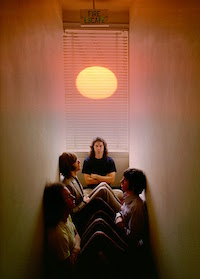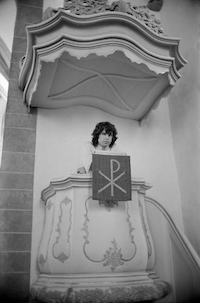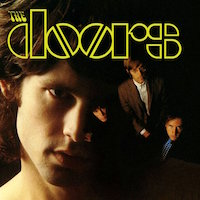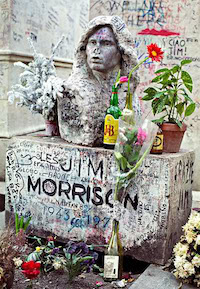Through his mysterious death in Paris in 1971, the charismatic and self-destructive Jim Morrison managed to create a legend.
 Morrison loved to pretend he was death, in shows.
Morrison loved to pretend he was death, in shows.
It is now more than half a century since The Doors published their first album in 1967. Although they only made music for five years, through his mysterious death in Paris in 1971, the charismatic and self-destructive Jim Morrison, managed to create a legend. He did not live to be the poet he wanted to be, but he has become a cult figure even today.
The death of Morrison was the last in a string of rock deaths, which began with Brian Jones of the Rolling Stones in 1969, and continued on with Janis Joplin and Jimi Hendrix in 1970, all at the age of 27 – although the doctor who saw Morrison’s body thought that he was 57. In order to understand his tragedy, we have to go back to his childhood. After The Doors began, Jim did not see his parents again, saying that his only family was his sister.
 The Doors opened to Psychedelia in 1967.
The Doors opened to Psychedelia in 1967.Jim’s grandparents, on the Morrison side, were southern Presbyterians, working people who were fearful of God. His father followed in the family military tradition and was posted to Hawaii just before the Japanese attack on Pearl Harbour. He was an admiral in Vietnam, when his son became famous for his opposition to the war. Whenever he was asked about his childhood, there is an event that Jim tells again and again, announcing his own mysterious death.
One day, first thing in the morning, the family was driving through the dessert of New Mexico when his father came off the road onto a ditch, somewhere between Albuquerque and Santa Fe. There had been a head-on collision between a car and a lorry driven by Indians. Their bodies were “scattered on dawn’s highway bleeding”. The anguished voice of a woman could be heard wailing hysterically. When the boy tried to get out of the car with his father and grandfather to see what was happening, his mother stopped him, but he pressed his face to the window.
Years later, speaking into a microphone in a dark recording studio in western Hollywood, he would say that, “the reaction I get now, thinking back, looking back, is that, possibly the soul of one of those Indians, maybe several of them, just ran over and jumped into my brain”. The fact is that from then on he started to wet the bed, worried that he would fall asleep. He would lie curled up on the floor, until his mother woke him up, furious. He recounted this in tears to his lawyer in relation to a court case in 1969, also making allusions to possible sexual abuse from a close family member, which his mother denies, calling him a liar.
THE LIZARD KING
That proximity to the desert gave him a fascination for reptiles, acquiring his famous nickname of The Lizard King. He moved from one house to another, depending on his father’s posting, in continuous conflict with his mother. He was fascinated by the film Rebel without a cause (1955) by James Dean. That absence of a home resulted in him never owning a house, or even renting a flat. He used to live with his girlfriends, sometimes in motels, or he simply slept on the sofa of The Doors’ office space, which is now a Mexican restaurant, where you can see the bathroom in which he recorded one of his last songs–.
 Morrison was attracted by pulpits, like this one of a Lutheran church in Frankfurt, 1968.
Morrison was attracted by pulpits, like this one of a Lutheran church in Frankfurt, 1968.His exhibitionist behaviour led him to pretend fainting whenever he went to school, as he would later do time and again on stage. Like the beat generation poets, Morrison read Nietzsche, and Kerouac dedicated “On the Road” to him. Solitary and depressed, he stayed up late listening to the incendiary sermons of southern evangelical preachers, which were broadcast on Christian radios. His first girlfriend remembers that he once told her that he had a problem that he couldn’t talk to his parents about. She took him to the youth pastor of the Westminster Presbyterian church (Alexandria, Washington). Jim never told her what they had talked about…
He stopped going to church when he went to live with his grandparents in Florida. In 1962 he started going to a beatnik style café – the Contemporary-, where something happened that would distance him from that world. He told his lawyer that he had had a homosexual experience. From then on his attitude became increasingly strange. He burst into a black evangelical meeting which was being held in a tent, and had to be kicked out by a group of angry ministers. In the Mexican district of Los Angeles, preachers would stand on Olivera street, close to the old Mission and Pershing square. Once, when one of them came down from his box, he got up and started giving his own incendiary sermon, until the indignant evangelist got him down by force.
THE DOORS OF PERCEPTION
The expression of the poet William Blake in “The Marriage of Heaven and Hell” (1793) – “If the doors of perception were cleansed, everything would appear to man as it is, infinite.” – lends itself not only to a book by Aldous Huxley, but also to the name of The Doors. It refers to the psychedelic experience that some authors started to have with LSD, when it was still legal in the United States. Morrison studied cinema at that time in California with Ray Manzarek, with whom he formed the band after a meeting on Venice Beach. His most famous classmate however was Francis Ford Coppola, who used his song “The End” at the beginning of his particular vision of Conrad’s “The Heart of Darkness” in the Vietnam War, Apocalypse Now (1979).
 Morrison talking to Fred Stiegemeier, pastor of a Reformed Evangelical Church, in 1968.
Morrison talking to Fred Stiegemeier, pastor of a Reformed Evangelical Church, in 1968.It was a Berkeley graduate, Felix Venable, who gave Morrison his first taste of LSD, but he also turned him into an alcoholic, even before he could buy beer legally. Because despite being known for his psychedelic shamanism, his biographer Stephen Davis shows that the thing that ultimately destroyed Jim Morrison was alcohol. In 1964, Jim even began to drink gin for breakfast. Manzarek however, had swapped LSD for eastern meditation. At the yogi Maharishi centre he met the other members of The Doors: John Desmore and Robby Krieger.
The Maharishi had founded his Spiritual Regeneration Movement in India in 1957, but had moved to Los Angeles in 1960. The sect did not become a multinational until it was made famous by the Beatles. In 1965 Transcendental Meditation already had few followers,but it soon started attracting young musicians, including various of the Beach Boys. Three of the four members of the Doors had sought spiritual illumination in this cult. “Even Jim in his way”, Manzarek later said in a radio interview. Morrison said that he composed Take It As It Comes for yogi Maharishi.
THE END
Having become the new sex symbol of the Sunset Strip, Morrison was the image of a band whose music has been described as “a churchy-cum-carnivalesque sound that made their concerts seem like a doomy chapel of extreme experience” (Stephen Davis). Riding on a wave of permanent intoxication, as his agent Ronnie Haran remembers, Jim was becoming crazed. Obsessed by death, Morrison told Haran, while moving with his girlfriend Pam to a house in the Laurel Canyon: “In a few years I’ll be dead”.
On the night that he recorded The End,someone found Jim in a large catholic church on the other side of Sunset Boulevard. Morrison took away a large prayer book, which he then tore up back at the studio, page by page, as he sang to the death of his father and the rape of his mother. She tried to contact him through his record company, when Light my Fire reached number one during the Summer of Love in 1967–, but he did not return her calls. In Washington she tried to see him at one of his concerts, but he did not admit here. He would never talk to her again.
 Half a century ago, The Doors introduced themselves with their first album.
Half a century ago, The Doors introduced themselves with their first album. Their next album, Strange Days (1967), closes with a song –When the Music´s Over– which at first appears to be a denial of faith, full of sexual imagery, but it ends with intense spiritual unrest, shouting out the name of Jesus, in search of salvation. At the same time through he defined his epic poem Celebration of the Lizard as an “invocation of dark forces”. Patricia Kennealy, the editor of a music magazine, goes so far as to say that he married her in a witch ceremony, which she recreates in the film by Oliver Stone.
The poem Texas Radio is inspired by the preachers that he used to listen to in the early hours of the morning, when he was in high school. It would feature almost in full in his concerts. In Saratoga Springs there is footage of an incident when a Methodist pastor came up to him while he was doing sound tests. He was a middle-aged man who smoked a pipe and wore a dog collar. He told him that his concert was a religious experience, to which he replied that The Doors was a form of secular religion.
AN AMERICAN PRAYER
An album has recently been released with the recording of a concert in Vancouver, including a song that they recorded for their fourth album, The Soft Parade(1969): Petition The Lord With Prayer. This particularly urgent prayer starts with the introduction “When I was back there in Seminary School”. His best known poem is entitled An American Prayer. The problem is that, for Morrison, religion included everything, from sex and drugs to philosophy and literature.
 Morrison's tomb in Paris has been a place of peregrination since his death in 1971.
Morrison's tomb in Paris has been a place of peregrination since his death in 1971.On the day of the Miami incident (when he was charged for indecent exposure at a concert), he was wearing a cross around his neck. When they asked him what it meant, he said: “I was raised in a Christian culture and the cross is one of its symbols, that's all.”. His religion, like American society, could not save him. As he said in 1970, not even love could save you from your destiny. Looking unkempt, overweight and with a long beard, he escaped to Paris, tormented and shattered, to join Pam. She was addicted to heroin and he was drinking continuously.
One of the notebooks that he carried with him everywhere in a plastic bag just before his death in 1971, is full of poems expressing anguish at the thought of death; prayers and obscenities. One page is full of the scribbled and repeated words: God help me. No one knows for sure what happened the night before he appeared dead in a bathtub, but he may have been miserably lonely. The tragedy of his life and his death appears to be a desperate plea to a God that doesn’t listen.
God has however loved us to the point of giving his only Son for us (John 3:16). He shows compassion for our weaknesses, because he was tempted in everything, in our very image (Hebrews 3:15). And he invites us to come to his throne of grace, to touch his mercy and timely salvation (v. 16). This is our only hope.

Las opiniones vertidas por nuestros colaboradores se realizan a nivel personal, pudiendo coincidir o no con la postura de la dirección de Protestante Digital.
Si quieres comentar o